A finish to the week with a small range inside day does not change the Elliott wave count. The target remains the same and the wave count has strong support from classic technical analysis.
Summary: An upwards breakout above 2,940 with support from volume adds confidence in the wave count. The next target is 3,120. Classic analysis very strongly supports this main wave count.
The biggest picture, Grand Super Cycle analysis, is here.
Monthly charts were last published here, with video here. There are two further alternate monthly charts here, with video here.
ELLIOTT WAVE COUNTS
The two weekly Elliott wave counts below will be labelled First and Second. They may be about of even probability. When the fifth wave currently unfolding on weekly charts may be complete, then these two wave counts will diverge on the severity of the expected following bear market. To see an illustration of this future divergence monthly charts should be viewed.
FIRST WAVE COUNT
WEEKLY CHART
The basic Elliott wave structure consists of a five wave structure up followed by a three wave structure down (for a bull market). This wave count sees the bull market beginning in March 2009 as an incomplete five wave impulse and now within the last fifth wave, which is labelled cycle wave V. This impulse is best viewed on monthly charts. The weekly chart focusses on the end of it.
Elliott wave is fractal. This fifth wave labelled cycle wave V may end a larger fifth wave labelled Super Cycle wave (V), which may end a larger first wave labelled Grand Super Cycle wave I.
The teal Elliott channel is drawn using Elliott’s first technique about the impulse of Super Cycle wave (V). Draw the first trend line from the end of cycle wave I (off to the left of the chart, the weekly candlestick beginning 30th November 2014) to the end of cycle wave III, then place a parallel copy on the end of cycle wave II. This channel perfectly shows where cycle wave IV ended at support. The strongest portion of cycle wave III, the end of primary wave 3, overshoots the upper edge of the channel. This is a typical look for a third wave and suggests the channel is drawn correctly and the way the impulse is counted is correct.
Within Super Cycle wave (V), cycle wave III is shorter than cycle wave I. A core Elliott wave rule states that a third wave may never be the shortest. For this rule to be met in this instance, cycle wave V may not be longer in length than cycle wave III. This limit is at 3,477.39.
Cycle wave V may subdivide either as an impulse or an ending diagonal. Impulses are much more common. This main wave count expects that cycle wave V may be unfolding as an impulse.
The daily chart below will now focus on all movement from the end of primary wave 1.
In historic analysis, two further monthly charts have been published that do not have a limit to upwards movement and are more bullish than this wave count. Members are encouraged to consider those possibilities (links below summary) alongside the wave counts presented on a daily and weekly basis.
DAILY CHART
Cycle wave V is seen as an impulse for this wave count.
Within cycle wave V, primary waves 1 and 2 may be complete. Primary wave 3 may have begun.
Primary wave 3 may only subdivide as an impulse. Within primary wave 3, intermediate waves (1) and (2) may be complete.
Intermediate wave (3) may have begun. Intermediate wave (3) may only subdivide as an impulse.
Within intermediate wave (3), minor waves 1 and 2 may be complete. Within minor wave 3, minute waves i and ii may be complete. Within minute wave iii, no second wave correction may move beyond its start below 2,834.97.
All of primary wave 3, intermediate wave (3), minor wave 3 and minute wave iii may only subdivide as impulses.
Intermediate wave (3) must move far enough above the end of intermediate wave (1) to then allow intermediate wave (4) to unfold and remain above intermediate wave (1) price territory.
HOURLY CHART
Within minor wave 3, minute waves i and ii may be complete. Minute wave iii may only subdivide as an impulse. Within the impulse of minute wave iii, minuette wave (i) may be incomplete.
Within minuette wave (i), subminuette waves i and ii may be complete. Subminuette wave iii may be incomplete. Within subminuette wave iii, micro wave 4 may not move into micro wave 1 price territory.
Micro wave 4 may be unfolding as an extremely rare expanding triangle. Sub-micro wave (E) must end below the end of sub-micro wave (C) at 2,972.51 for the triangle to complete and be valid. If this structure completes as labelled and remains valid, then it may be only the second expanding triangle that I have seen.
Micro wave 4 may also be unfolding as a combination or flat correction.
SECOND WAVE COUNT
WEEKLY CHART
This weekly chart is almost identical to the first weekly chart, with the sole exception being the degree of labelling.
This weekly chart moves the degree of labelling for the impulse beginning in March 2009 all down one degree. This difference is best viewed on monthly charts.
The impulse is still viewed as nearing an end; a fifth wave is still seen as needing to complete higher. This wave count labels it primary wave 5.
TECHNICAL ANALYSIS
WEEKLY CHART
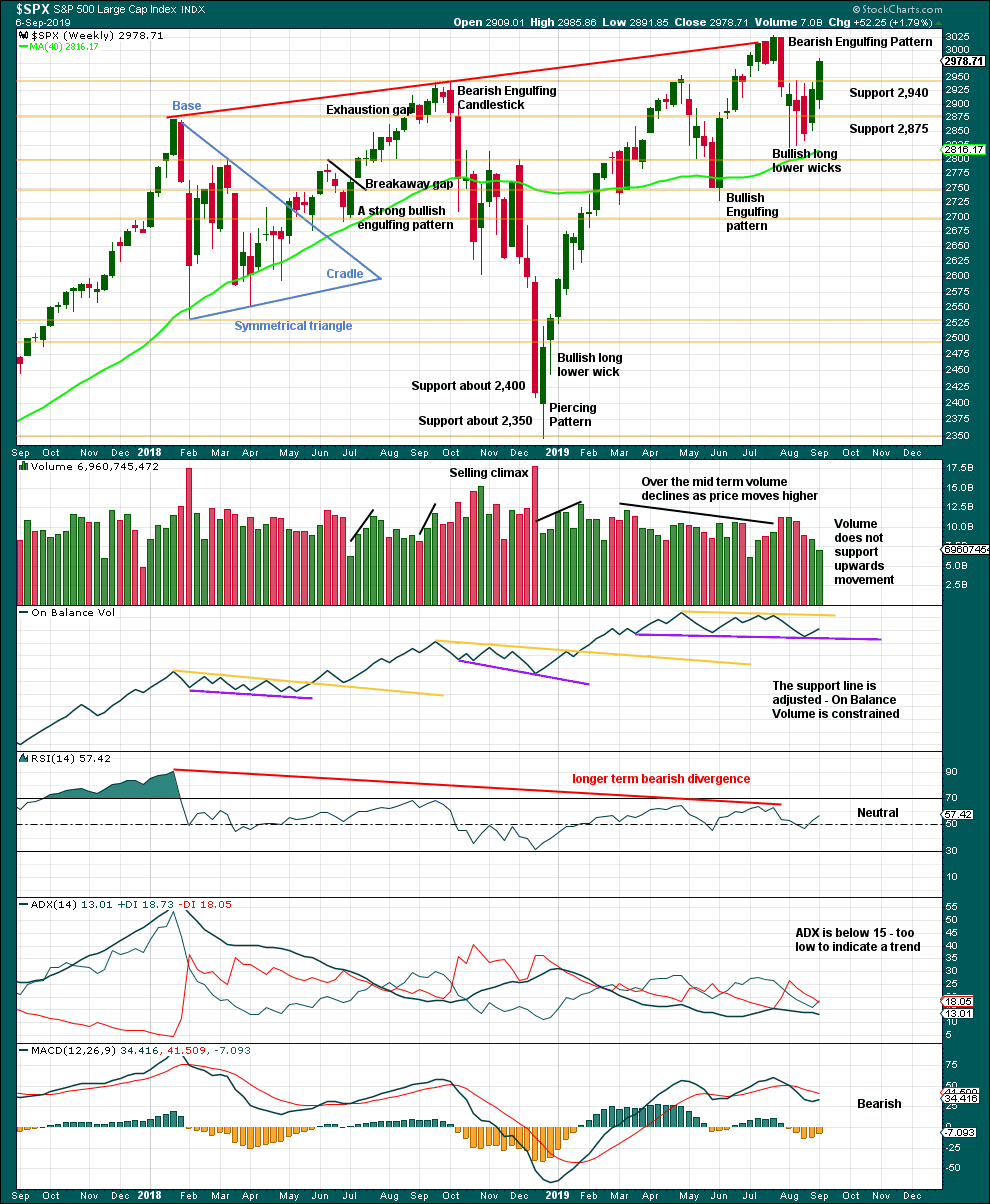
Click chart to enlarge. Chart courtesy of StockCharts.com.
This week has effected an upwards breakout from a small range of the prior three weeks. While the breakout does not have support from volume at the weekly chart level, it does at the daily chart level for the day of the breakout.
DAILY CHART
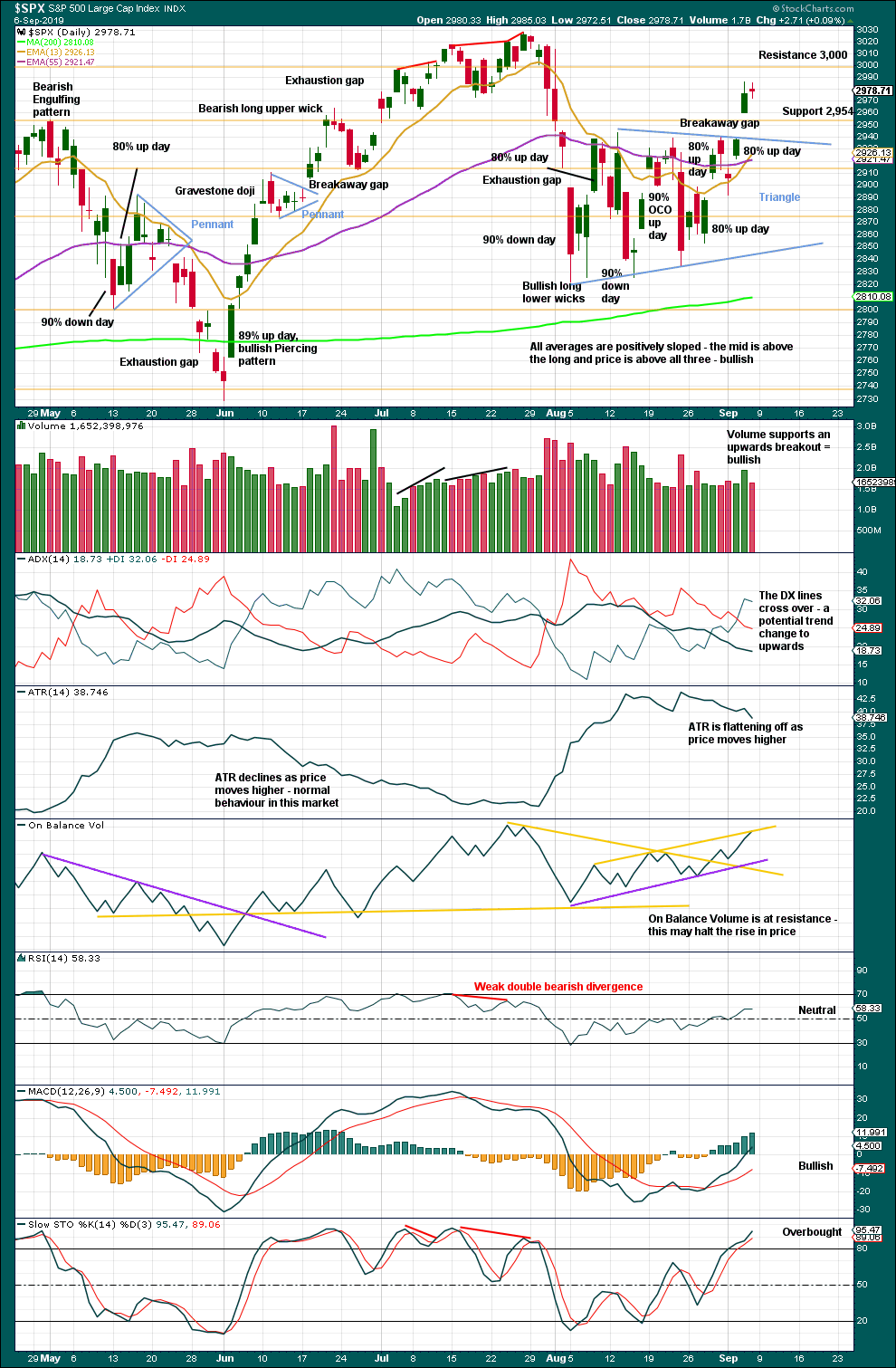
Click chart to enlarge. Chart courtesy of StockCharts.com.
The last low of the 15th of August was preceded immediately by a 90% downward day and followed immediately by a 90% OCO (Operating Companies Only) up day. This is a pattern commonly found at major lows, and it indicates a 180 degree shift in sentiment from bearish to bullish. This favours the main Elliott wave count.
Now the next low of the 23rd of August has been followed by two back to back 80% up days. This too is very bullish and favours the main Elliott wave count.
There is now an upwards breakout above the triangle pattern with support from volume and a breakaway gap. The breakaway gap may offer support at 2,938.84.
A target from the triangle pattern is 3,060.
Look for next resistance about 3,000.
BREADTH – AD LINE
WEEKLY CHART
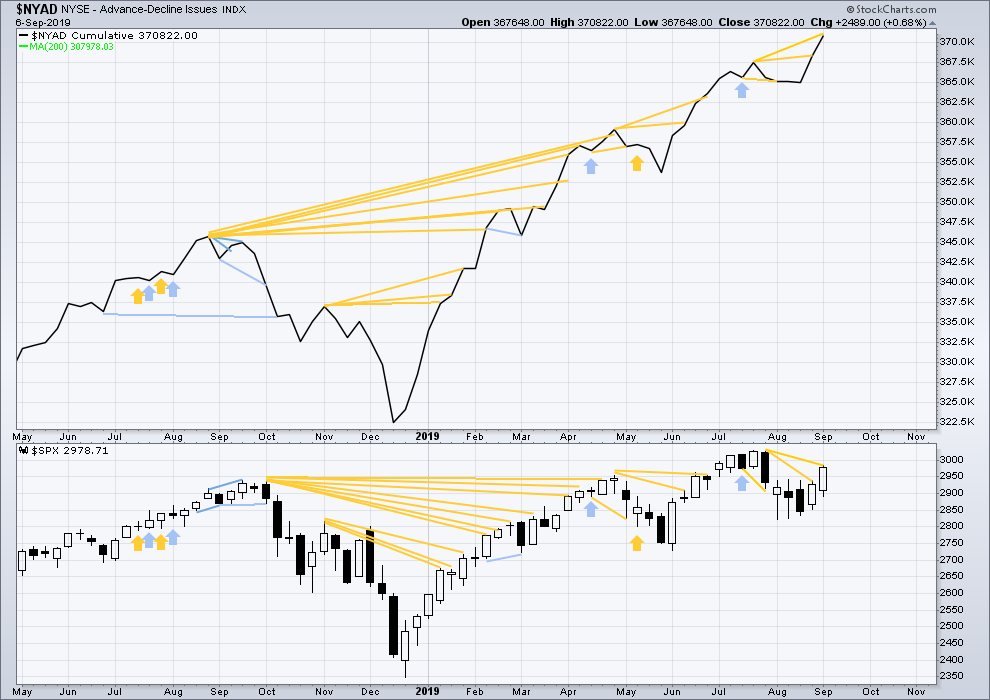
Click chart to enlarge. Chart courtesy of StockCharts.com. So that colour blind members are included, bearish signals
will be noted with blue and bullish signals with yellow.
Bear markets from the Great Depression and onwards have been preceded by an average minimum of 4 months divergence between price and the AD line with only two exceptions in 1946 and 1976. With the AD line making new all time highs again this week, the end of this bull market and the start of a new bear market is very likely a minimum of 4 months away, which is the beginning of January 2020.
In all bear markets in the last 90 years there is some positive correlation (0.6022) between the length of bearish divergence and the depth of the following bear market. No to little divergence is correlated with more shallow bear markets. Longer divergence is correlated with deeper bear markets.
If a bear market does develop here, it comes after no bearish divergence. It would therefore more likely be shallow.
Again, this week both price and the AD line have moved higher.
The AD line makes a new all time high. This is a very bullish signal and very strongly supports the Elliott wave count.
DAILY CHART
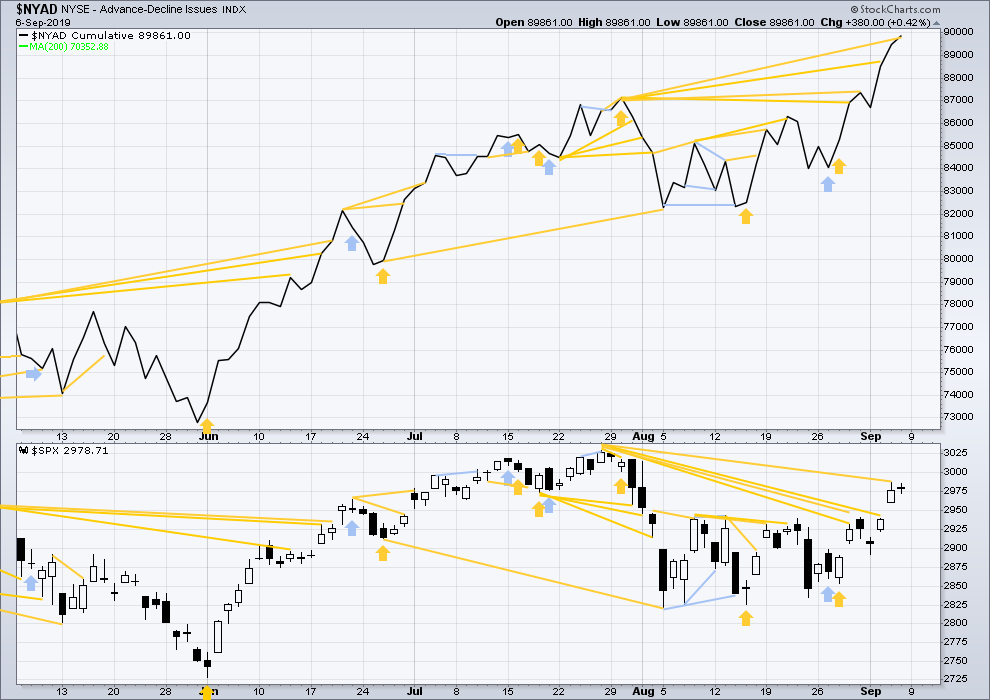
Click chart to enlarge. Chart courtesy of StockCharts.com. So that colour blind members are included, bearish signals
will be noted with blue and bullish signals with yellow.
Breadth should be read as a leading indicator.
Again, the AD line makes another new all all time high. This is a very bullish signal and strongly favours the Elliott wave count.
VOLATILITY – INVERTED VIX CHART
WEEKLY CHART
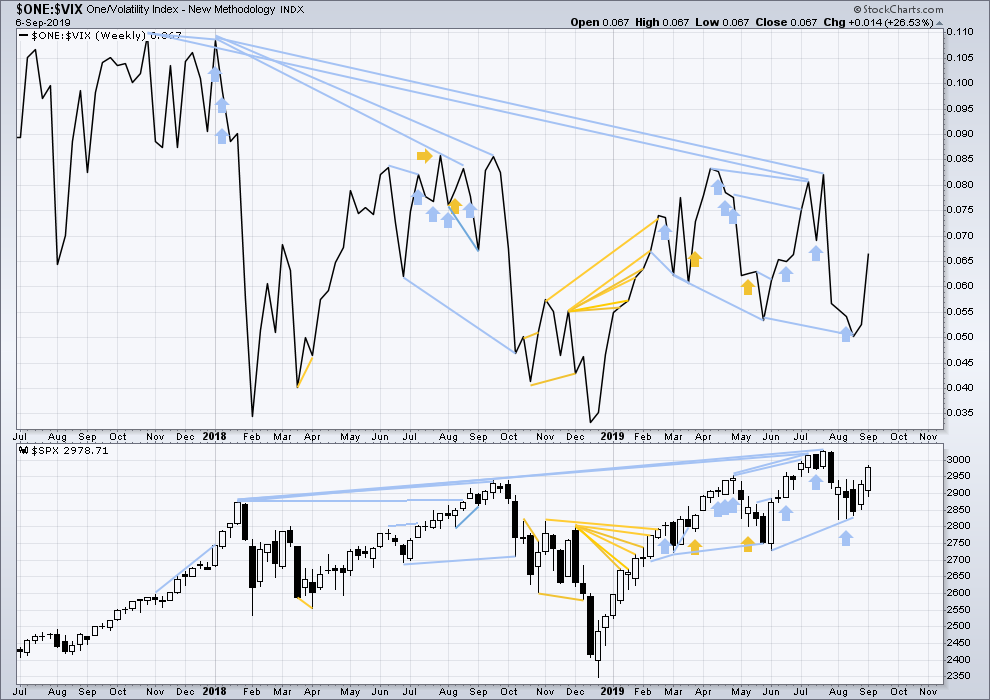
Click chart to enlarge. Chart courtesy of StockCharts.com. So that colour blind members are included, bearish signals
will be noted with blue and bullish signals with yellow.
The all time high for inverted VIX (which is the same as the low for VIX) was on 30th October 2017. There is now nearly one year and ten months of bearish divergence between price and inverted VIX.
The rise in price is not coming with a normal corresponding decline in VIX; VIX remains elevated. This long-term divergence is bearish and may yet develop further as the bull market matures.
This divergence may be an early warning, a part of the process of a top developing that may take years. It may not be useful in timing a trend change.
This week both price and inverted VIX have moved higher. There is no new divergence.
DAILY CHART
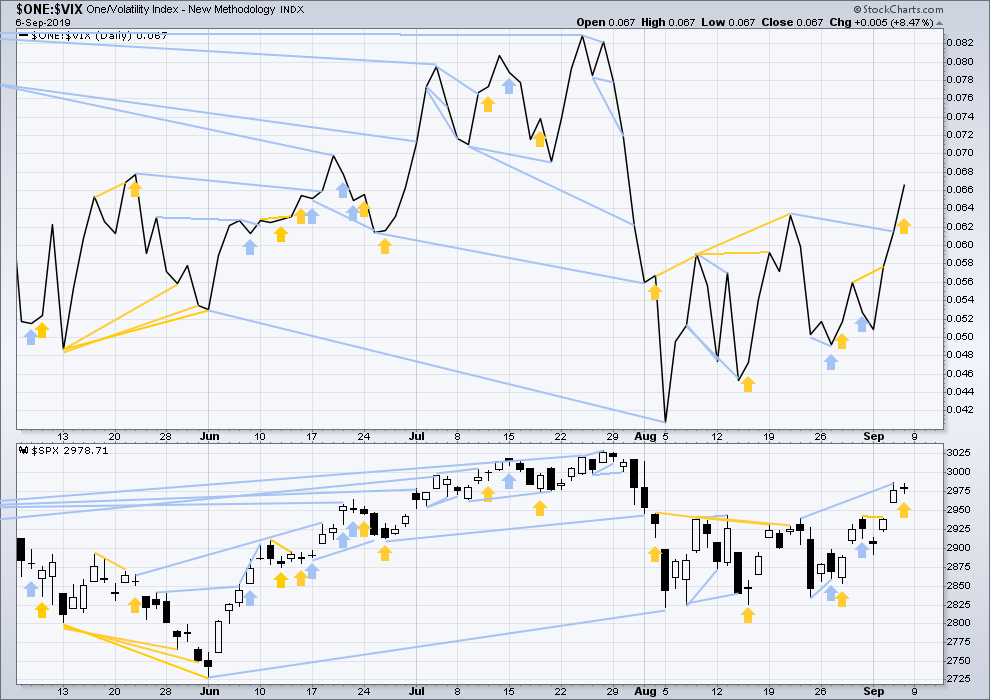
Click chart to enlarge. Chart courtesy of StockCharts.com. So that colour blind members are included, bearish signals
will be noted with blue and bullish signals with yellow.
On Friday price moved sideways to complete and inside day, but inverted VIX has moved strongly higher. This divergence is very bullish and confirms bullish divergence in the AD line. This supports the Elliott wave count.
DOW THEORY
Dow Theory confirmed a bear market in December 2018. This does not necessarily mean a bear market at Grand Super Cycle degree though; Dow Theory makes no comment on Elliott wave counts. On the 25th of August 2015 Dow Theory also confirmed a bear market. The Elliott wave count sees that as part of cycle wave II. After Dow Theory confirmation of a bear market in August 2015, price went on to make new all time highs and the bull market continued.
DJIA: 23,344.52 – a close on the 19th of December at 23,284.97 confirms a bear market.
DJT: 9,806.79 – price has closed below this point on the 13th of December.
S&P500: 2,532.69 – a close on the 19th of December at 2,506.96 provides support to a bear market conclusion.
Nasdaq: 6,630.67 – a close on the 19th of December at 6,618.86 provides support to a bear market conclusion.
With all the indices having moved higher following a Dow Theory bear market confirmation, Dow Theory would confirm a bull market if the following highs are made:
DJIA: 26,951.81 – a close above this point has been made on the 3rd of July 2019.
DJT: 11,623.58 – to date DJT has failed to confirm an ongoing bull market.
S&P500: 2,940.91 – a close above this point was made on the 29th of April 2019.
Nasdaq: 8,133.30 – a close above this point was made on the 26th of April 2019.
Published @ 11:44 p.m. EST.
—
Careful risk management protects your trading account(s).
Follow my two Golden Rules:
1. Always trade with stops.
2. Risk only 1-5% of equity on any one trade.
—
New updates to this analysis are in bold.

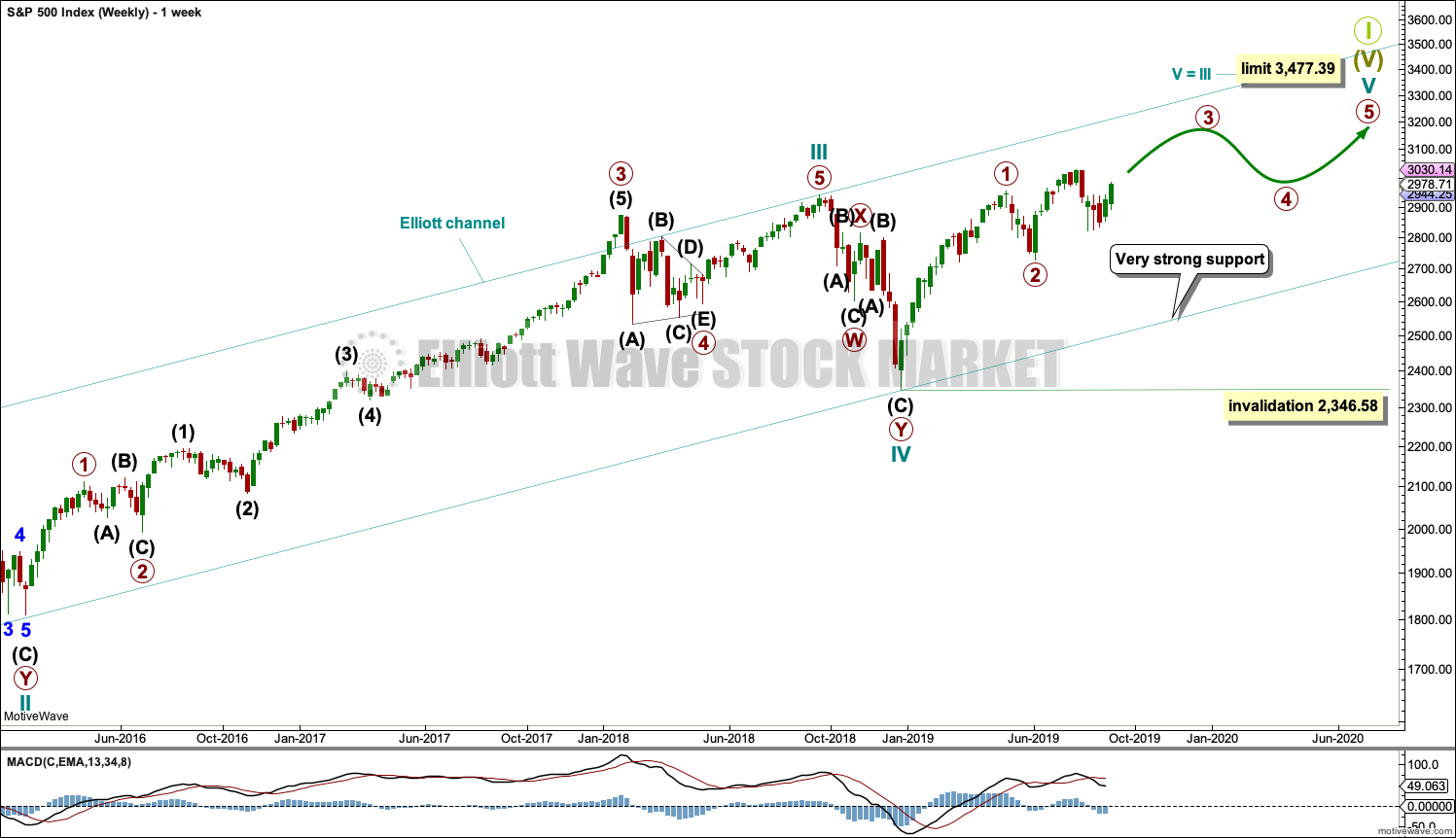
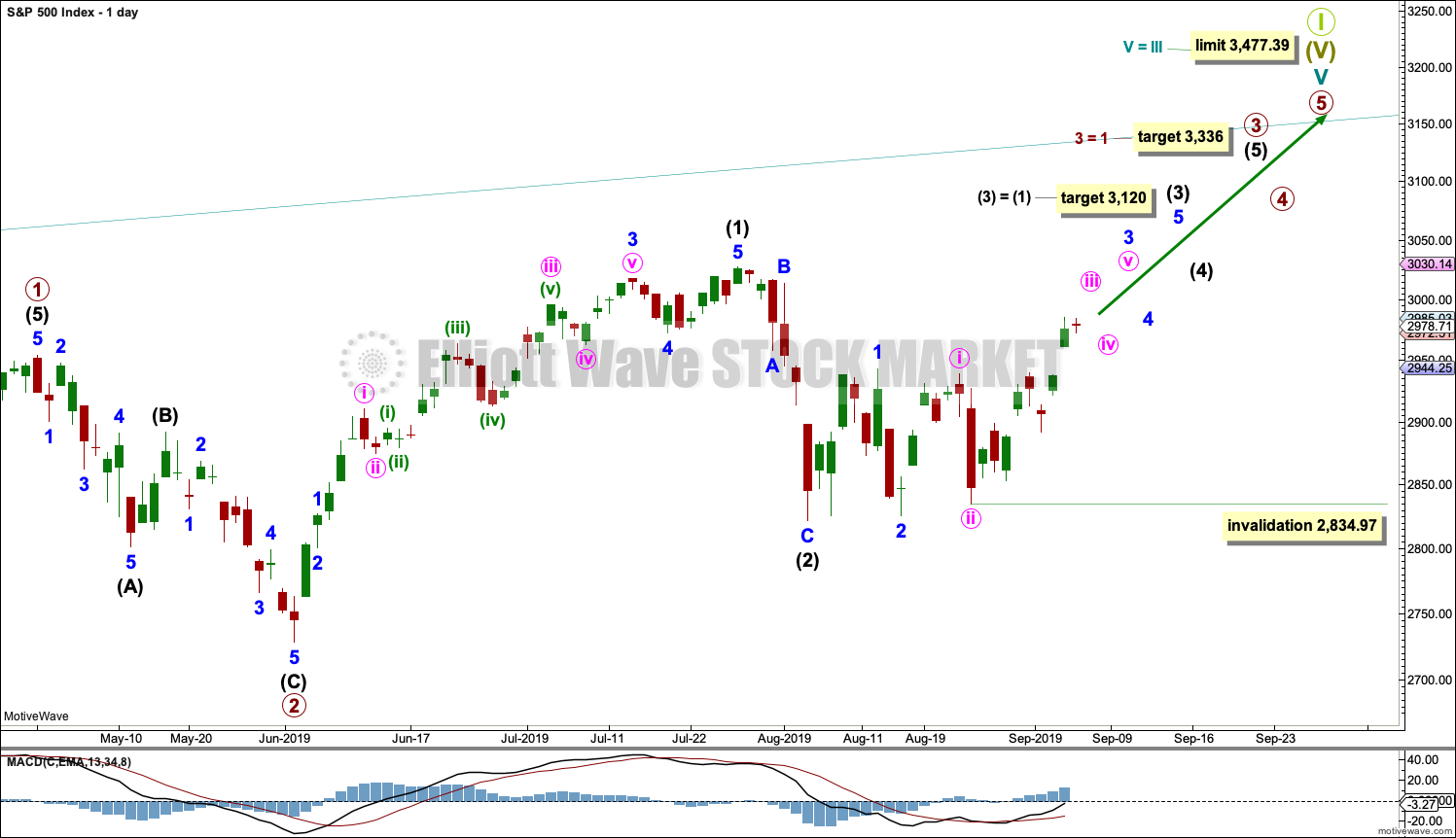
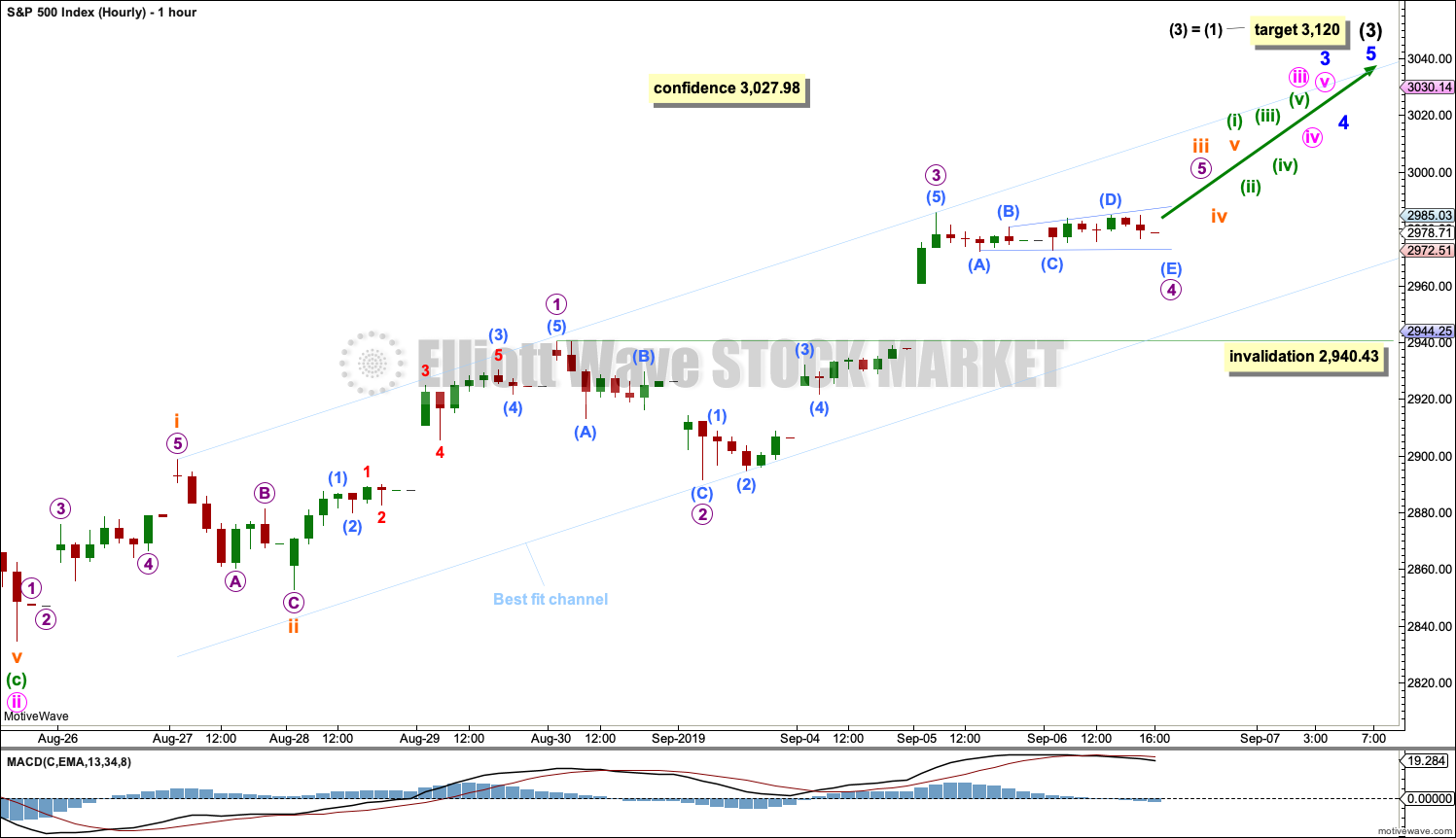
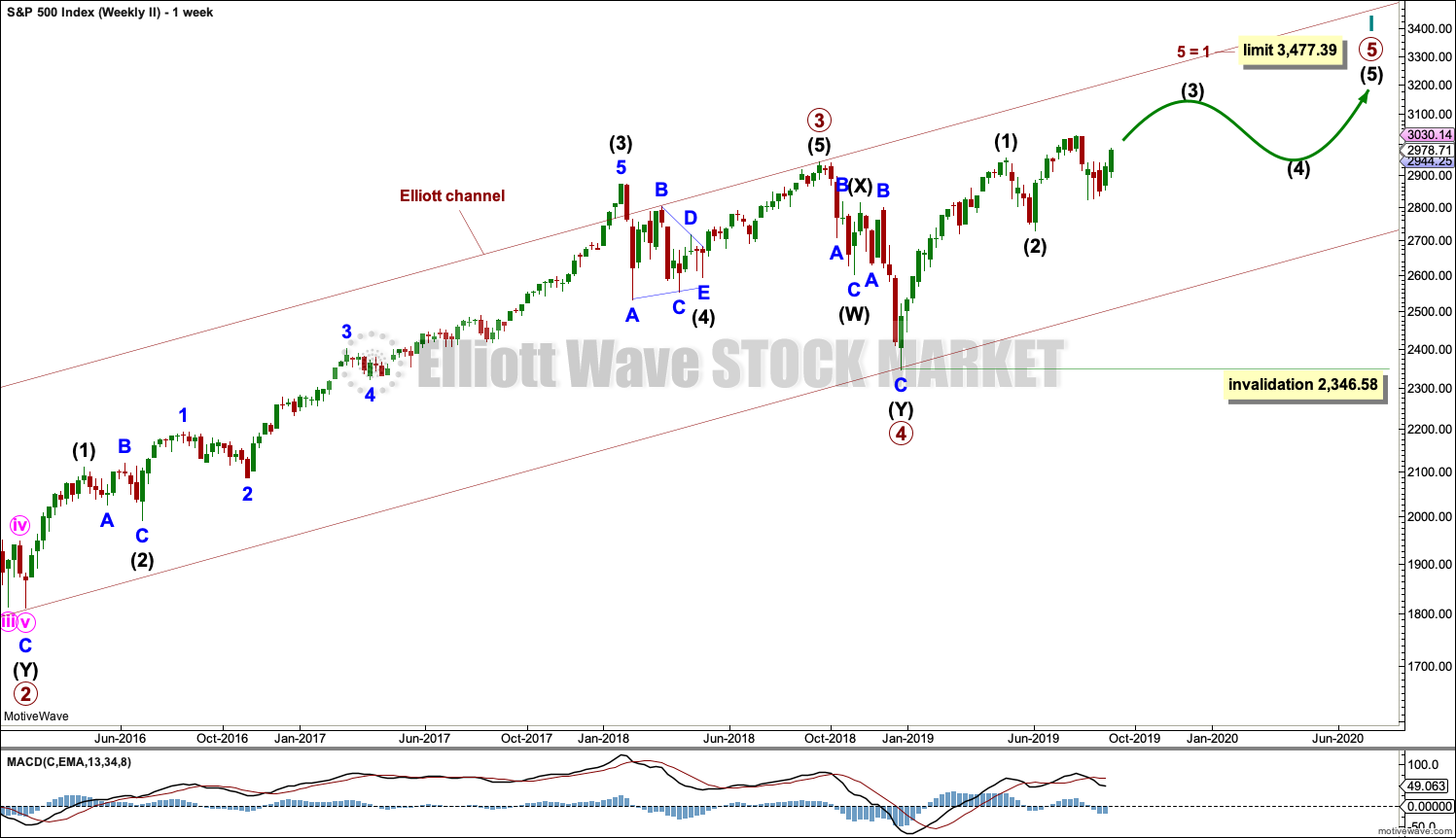
Micro 4 doesn’t fit as an expanding triangle 🙁 Wave C didn’t move beyond the end of wave A, the rules weren’t met.
It will fit as an expanded flat though, which may now be complete.
I still need to adjust labelling of sub-micro (A) and (B) a bit… but it fits.
No surprise to me, Lara. I recall what you’ve often said about triangles!
I read a report that the std. deviation of advisor bullish/bearish sentiment is at some extraordinary high. Confusion reigns! Spent $7 to hang in one trading room for a month to see what I can learn, and what I hear from just about every talking head there is a lack of any belief this market can run up per our main count; generally bearish sentiment dominates, and even with what casually to me looks like a very bullish daily chart, they find “technical” reasons why it’s not. Interesting. We’ll see!
A contrarian would see that as bullish. When everyone is bearish and cannot see the market rising, that is when conditions could be right for it to do so.
Still waiting for the minuette iv in RUT to show signs of completion to get long.
Didn’t have to wait long, took it with the higher swing low on the 1 and 5 minute.
i jumped on just in time! thanks…
then went short..
very nimble. I only closed the long. too bullish at the hour+ tf’s to short the 5 and 1 min for me.
long again, good luck!
lol!! we are in phase.
what weapons are you using? UWM/TWM? Or puts and calls? I’m using UWM.
trading futures contracts intra day…..
/ES 4 hour with overnight data. My targets based on symmetric projections and Fibonacci levels. Might first stall and some some kind of a iv on 76-78% level, then push up to complete the minute iii at the ATH (100%) and 162% of the prior swing.
In the ES, minute ii finishes beyond the start of minute i whereas in the cash index it doesn’t.
I have Minor 2 finishing at this spot on the ES as a flat.
Noted and corrected, thanks.
Unreal. Two in a row. Weekend champ. But nothing will help get rid of my sadness that my Chicago Bears lost to the Packers last evening.
Ah, ya caught me nappin’ again. Well, it was playin’ guitar and writing to be more accurate, but geez where are my priorities. Right where they should be, most times.
Jump on the 49’r bandwagon, they may surprise this year!